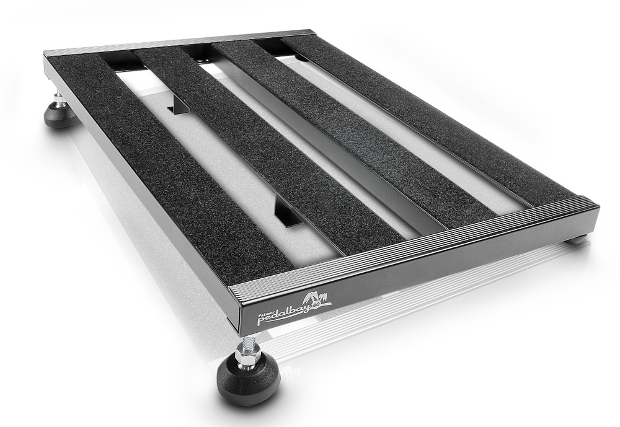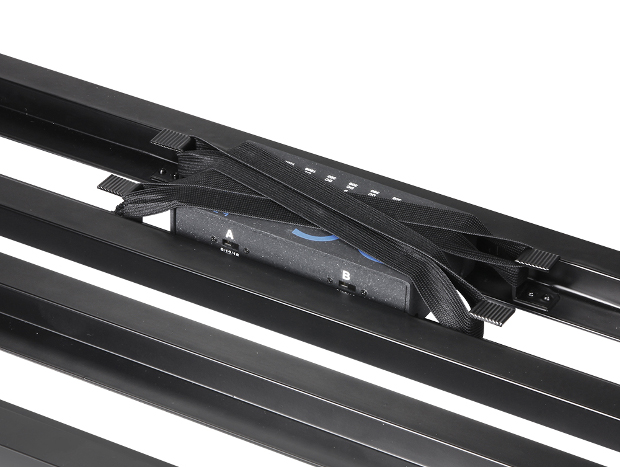Palmer Pedalbay 40 & 60 – Top class stomp box management – Product review by Amazona.de
Let’s face it, the phallus-like alignment of big full stacks have always drawn attention to themselves; but what guitarist enjoy finally being able to go all out with the power amp at a suitable open-air concert (the constructions are, unfortunately, too loud for club shows). On the other hand, the personal note of the artist is, and has always been, created by the wild connections and wiring of little pedals, stomp boxes, switches – or whatever you want to call them.

Countless little helpers, in the tens of thousands, make it possible for the musician to expand, improve or simply manage their creative ideas, whether in the studio or on stage. But all these little helpers have more or less the same problem. While a single tuner might sit uncomplaining in the corner of the stage, once there are a couple more things on stage, the cabling needed for signal flow and power supply becomes a bit of a pain. Pedals slip around the sticky stage floor, the internal tension of the patch cables can twist the pedal by up to 90 degrees, and every second switching operation makes the little plug of the power cable slip out of the pedal, letting the creative outpourings of the artist drift off into oblivion.
By this stage, even the most patient musician loses their cool, and goes out looking for a pedal board. Often they first try grandma’s cupboard shelf, with stuck-on three-point sockets for the countless plugs and nailed-on rubber feet from the hardware store. Once everyone has had a good laugh about this construction at the next festival, they consider spending a little money and investing in a professional version, after all.
Whether you ask for advice in a retail store, online or from other musicians, the name Pedaltrain will almost always come up. The concept is simple yet effective, and dominates the market above a certain standard of quality. As always, when an American company has an idea, a vast number of patents are applied to the product, and they set a high selling price to remain in pole position for as long as possible. But anyone who thinks they have to grin and bear it doesn’t yet know about the Pedalbay concept from the company Palmer, based in the German state of Hesse.

Construction
What characterises the Pedalbay concept? Compared to most pedal boards, which only have a flat board (generally made of wood) available to fix the pedals to, the Pedalbay concept is based on a slant. This means that all the cabling can be placed both over and also under the supporting surface. The Pedalbay series includes 5 different sizes. In this test, we have the versions 40 and 60.
Both products have a depth of 30 cm, with a width of 40 or 60 cm respectively. The supporting surface is made of four cross bars, of which the spacing of the two middle ones can be adjusted with the included Allen key to suit the attached pedal. All cross bars are covered with Velcro fleece, and a roll of self-adhesive hook strap is included for the underside of the pedals. The design means that a pedal can also be easily attached to the Palmer Pedalbay with cable ties.

Practice
So far, so good, the real big hit is on the underside of the construction. There are four hooks and two rubber bands (included) to attach all standard power supply cables underneath the boards, instead of them taking up important space on the top of the device. The height-adjustable feet on the top of the board means that there is also space for knobbly power supply versions, meaning you are not necessarily dependant on the high-price US versions.
This creates a huge amount of space on the top and also makes it look very tidy. If needed, the fiddly power cable can be wrapped once or twice around a cross bar, with the patch cable in the signal feed either over or under the cross bars. Plug in a power cable and you’re done! What a relief!
The pedals are transported in a robust, padded carry bag, which features zips that, unlike those of the competition, don’t give the impression that they will need to be replaced after ten uses.

Conclusion:
With the Palmer Pedalbay, the Hesse-based company offers an excellent pedal board concept which is affordable and yet still very high quality. Targeted improvements means that Palmer not only manages to one up the teacher’s pet but also manages to outdo the competition when it comes to the integration of third-party manufacturers.
Clearly top marks, there is no alternative!
Plus
+ Design
+ rice-performance ratio
+ features
Minus
–
_____________________________________________
Source: Amazona.de, February 2015: http://www.amazona.de/test-palmer-pedalbay-40-60/
Author: Axel Ritt
You can find all the details about the Palmer Pedalbay 40 & 60 here:
http://www.palmer-germany.com/mi/en/Products/Pedalboards-and-Accessories/PEDALBAY-40-Lightweight-variable-Pedalboard-with-Protective-Softcase-45cm-PPEDALBAY40.htm
http://www.palmer-germany.com/mi/en/Products/Pedalboards-and-Accessories/PEDALBAY-60-Lightweight-variable-Pedalboard-with-Protective-Softcase-60cm-PPEDALBAY60.htm
Leave a Comment
You must be logged in to post a comment.












